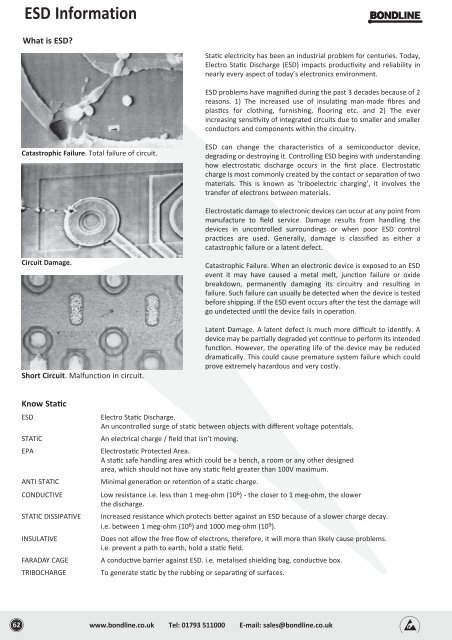Bonline_Catalogue_Issue10
You also want an ePaper? Increase the reach of your titles
YUMPU automatically turns print PDFs into web optimized ePapers that Google loves.
ESD Information<br />
What is ESD?<br />
Stac electricity has been an industrial problem for centuries. Today,<br />
Electro Stac Discharge (ESD) impacts producvity and reliability in<br />
nearly every aspect of today’s electronics environment.<br />
ESD problems have magnified during the past 3 decades because of 2<br />
reasons. 1) The increased use of insulang manmade fibres and<br />
plascs for clothing, furnishing, flooring etc. and 2) The ever<br />
increasing sensivity of integrated circuits due to smaller and smaller<br />
conductors and components within the circuitry.<br />
Catastrophic Failure. Total failure of circuit.<br />
ESD can change the characteriscs of a semiconductor device,<br />
degrading or destroying it. Controlling ESD begins with understanding<br />
how electrostac discharge occurs in the first place. Electrostac<br />
charge is most commonly created by the contact or separaon of two<br />
materials. This is known as ‘triboelectric charging’, it involves the<br />
transfer of electrons between materials.<br />
Electrostac damage to electronic devices can occur at any point from<br />
manufacture to field service. Damage results from handling the<br />
devices in uncontrolled surroundings or when poor ESD control<br />
pracces are used. Generally, damage is classified as either a<br />
catastrophic failure or a latent defect.<br />
Circuit Damage.<br />
Short Circuit. Malfunction in circuit.<br />
Catastrophic Failure. When an electronic device is exposed to an ESD<br />
event it may have caused a metal melt, juncon failure or oxide<br />
breakdown, permanently damaging its circuitry and resulng in<br />
failure. Such failure can usually be detected when the device is tested<br />
before shipping. If the ESD event occurs aer the test the damage will<br />
go undetected unl the device fails in operaon.<br />
Latent Damage. A latent defect is much more difficult to idenfy. A<br />
device may be parally degraded yet connue to perform its intended<br />
funcon. However, the operang life of the device may be reduced<br />
dramacally. This could cause premature system failure which could<br />
prove extremely hazardous and very costly.<br />
Know Stac<br />
ESD<br />
STATIC<br />
EPA<br />
ANTI STATIC<br />
CONDUCTIVE<br />
STATIC DISSIPATIVE<br />
INSULATIVE<br />
FARADAY CAGE<br />
TRIBOCHARGE<br />
Electro Stac Discharge.<br />
An uncontrolled surge of stac between objects with different voltage potenals.<br />
An electrical charge / field that isn’t moving.<br />
Electrostac Protected Area.<br />
A stac safe handling area which could be a bench, a room or any other designed<br />
area, which should not have any stac field greater than 100V maximum.<br />
Minimal generaon or retenon of a stac charge.<br />
Low resistance i.e. less than 1 megohm (10 6 ) the closer to 1 megohm, the slower<br />
the discharge.<br />
Increased resistance which protects beer against an ESD because of a slower charge decay.<br />
i.e. between 1 megohm (10 6 ) and 1000 megohm (10 9 ).<br />
Does not allow the free flow of electrons, therefore, it will more than likely cause problems.<br />
i.e. prevent a path to earth, hold a stac field.<br />
A conducve barrier against ESD. i.e. metalised shielding bag, conducve box.<br />
To generate stac by the rubbing or separang of surfaces.<br />
62<br />
www.bondline.co.uk Tel: 01793 511000 Email: sales@bondline.co.uk






